Mathura art
Mathura art refers to a particular school of Buddhist art, which centered on the city of Mathura, in central northern India, during the period in which Buddhism flourished in India. The art of Mathura is usually contrasted with the Greco-Buddhist art of Gandhara. In particular there is a debate about the origin of the Buddha image and the role played by each school of art. Before the creation of an image of the Buddha, probably around the 1st century CE, Indian Buddhist art had essentially been aniconic, avoiding representation of the Buddha, but rather relying on its symbols, such as the Wheel of the Law or the Bodhi tree.
Early history

Mauryan and Indo-Greek rule
Mathura was an important city of central northern India for the Maurya Empire, whose capital was in eastern India at Pataliputra. Mauryan art flourished during that period. Following the demise of the Mauryan Empire and its replacement by the Sunga Empire, numismatic, literary and epigraphic evidence suggest that the Indo-Greeks, when they invaded India, occupied the area of Mathura for close to a century from the time of Menander I until approximately 70 BCE, with the Sungas remaining eastward of Mathura. From numismatic, literary and epigraphic evidence, it seems that the Indo-Greeks had control over Mathura at some time, especially during the rule of Menander I (165-135 BC).[2] An inscription in Mathura discovered in 1988,[3] the Yavanarajya inscription, mentions "The last day of year 116 of Yavana hegemony (Yavanarajya)", suggesting the presence of the Indo-Greeks in the 2nd-1st century BC in Mathura down to 70 or 69 BC.[2] On the contrary, the Sungas, are known to have been absent from Mathura (no epigraphical or coin remains) and only located eastward of the Mathura region.[2]
The Parkham Yaksha (2nd-1st century BCE)
Some of the earliest works of art of the Mathura school are the Yakshas, monumental sculptures of earth divinities that have been dated to the 2nd-1st century BCE, possibly starting during the time of the Mauryas or after. These Yakshas, such as the Parkham Yaksha, although essentially Indian in style, usually suggest some Hellenistic influence, such as the geometrical folds of the drapery or the walking stance of the statues. The Parkham Yaksha is datable to period 200 BCE – 50 BC[4] According to Upinder Singh, the statue is 2.59 meters high. On stylistic grounds it should be dated to the 2nd/1st century BC, but an inscription in Brahmi suggest a 3rd century BC date. The inscription says "Made by Gomitaka, a pupil of Kunika. Set up by eight brothers, members of the Manibhadra congregation ("puga")." This inscription thus indicates that the statue represents the Yaksa Manibhadra.[5] According to John Boardman, the hem of the dress is derived from Greek art. Describing a similar statue, John Boardman writes: "It has no local antecedents and looks most like a Greek Late Archaic mannerism". Similar folds can be seen in the Bharhut Yavana.[6]
Indo-Scythian rule
From around 70 BCE, the region of Mathura fell to Indian rulers of the Mitra dynasty and then to the Indo-Scythian Northern Satraps under Rajuvula. Little is known precisely from that period on terms of artistic creation. The Indo-Scythian Rajuvula, ruler of Mathura, created coins which were copies of the Indo-Greek ruler Strato II, with effigy of the king and representation of Athena on the obverse.
The Mathura lion capital (1st century CE)
Rajuvula is also known for the famous Mathura lion capital which records events of the Indo-Scythian dynasty as well as their support of Buddhism. It is also an interesting example of the state of artistic attainment in the city of Mathura at the turn of our era. The capital portrays two lions reminiscent of the lions of the Pillars of Ashoka, but in a much cruder style. It also displays at its center a Buddhist triratana symbol, further confirming the involvement of Indo-Scythian rulers with Buddhism. The triratna is contained in a flame palmette, an element of Hellenistic iconography, and an example of Hellenistic influence on Indian art.
Kushan rule
Right image: Side view.
Mathura then became the capital of the Kushan Empire from around 30 CE.
Bodhisattva statues (2nd century CE)
One dated example of statuary from that period is the Bala Bodhisattva, which, although not from Mathura but from Sarnath clearly describes the state of artistic attainment under the rule of Kushan ruler Kanishka. The Bala Boddhisattva is also nearly identical in style with other known statues from Mathura but definitely dated with an inscription as is the case for the Bala Boddhisattva.
The style of these statues is somewhat reminiscent of the earlier monumental Yaksha statues, usually dated to a few centuries earlier. On the contrary, despite other known instances of Hellenistic influence on Indian art, very little, if anything at all can be seen in this type of statue. Especially the Greco-Buddhist art of Gandhara seems to have had little to no influence.[7]
- Seated Buddha or Bodhisattva in Abhaya Mudra
Buddha coinage (Circa 130 CE)
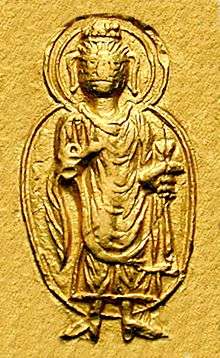
From his capital of Mathura or alternatively from the capital of his territories of the northwest, Peshawar, Kanishka issued the first known representation of the Buddha on a coin, and actually the first known representation of the Buddha that can be dated precisely, in this case, to the reign of Kanishka (127–150 CE). The Bimaran casket is usually dated to 50 CE, but with less certainty than the Kanishka coin.
Only six Kushan coins of the Buddha are known in gold (the sixth one is the centerpiece of an ancient piece of jewellery, consisting of a Kanishka Buddha coin decorated with a ring of heart-shaped ruby stones). All these coins were minted in gold under Kanishka I, and are in two different denominations: a dinar of about 8 gm, roughly similar to a Roman aureus, and a quarter dinar of about 2 gm. (about the size of an obol). The Buddha is represented wearing the monastic robe, the antaravasaka, the uttarasanga, and the overcoat sanghati. In general, the representation of the Buddha on these coins is already highly symbolic, and quite distinct from the more naturalistic and Hellenistic images seen in early Gandhara sculptures. On several designs a mustache is apparent. The palm of his right hand bears the Chakra mark, and his brow bear the urna. An aureola, formed by one, two or three lines, surrounds him. The full gown worn by the Buddha on the coins, covering both shoulders, suggests a Gandharan model rather than a Mathuran one, and the style is clearly Hellenistic.
Kanishka also issued other types of Buddhist coinage, representation a "Shakyamuni Buddha" standing and walking, as well as a seated "Maitreya Buddha". It should be noted however that Maitreya is a Bodhisattva and not a Buddha according to the Buddhist cannon.
The Mathura standing Buddha
The Mathura standing Buddha seems to be a slightly later development compared to the Bodhisattvas of the type of the Bala Bodhisattva. Although several are dated to the 2nd century CE, they often tend to display characteristics of Gupta art, especially with the very thin dress seemingly sticking to the body of the Buddha. These statues of the Buddha however tend to display characteristic and attitudes more readily seen in the Greco-Buddhist art of Gandhara: the head of the Buddha is surrounded by a halo, the clothing covers both shoulders, the left hand hold the gown of the Buddha while the other hand form an Abbhiya mudra, and the folds in the clothing are more typical of the Gandharan styles.[8]
In many respect, the standing Buddha of Mathura seems to be a combination of the local sculptural tradition initiated by the Yakshas with the Hellenistic designs of the Buddhas from the Greco-Buddhist art of Gandhara.[8]
Other sculptural works
The Mathura sculptures incorporate many Hellenistic elements, such as the general idealistic realism, and key design elements such as the curly hair, and folded garment.
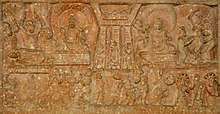
Specific Mathuran adaptations tend to reflect warmer climatic conditions, as they consist in a higher fluidity of the clothing, which progressively tend to cover only one shoulder instead of both. Also, facial types also tend to become more Indianized. Banerjee in Hellenism in ancient India describes "the mixed character of the Mathura School in which we find on the one hand, a direct continuation of the old Indian art of Barhut and Sanchi and on the other hand, the classical influence derived from Gandhara".[9]
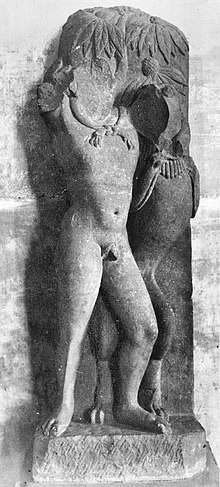
In some cases however, a clear influence from the art of Gandhara can also be felt, as in the case of the Hellenistic statue of Herakles strangling the Nemean lion, discovered in Mathura, and now in the Kolkota Indian Museum, as well as Bacchanalian scenes.[10][11][12] Although inspired from the art of Gandhara, the portraiture of Herakles is not perfectly exact and may show a lack of understanding of the subject matter, as Herakles is shown already wearing the skin of the lion he is fighting.[13][14]
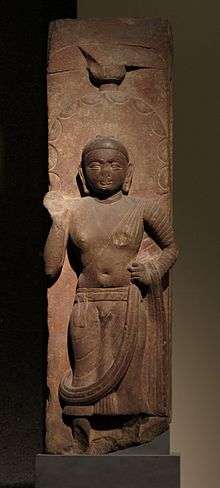 A Bodhisattva, 2nd century, Mathura.
A Bodhisattva, 2nd century, Mathura.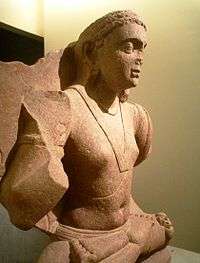
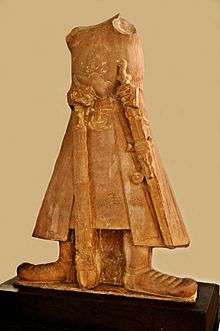 Statue of Kanishka I, 2nd century CE, Mathura Museum.
Statue of Kanishka I, 2nd century CE, Mathura Museum.- The Saptarishi Tila statue from Mathura ca. 2nd century CE.
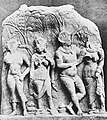 Bacchanalian scene Mathura.
Bacchanalian scene Mathura.
Hindu art
Hindu art started to develop from the 1st to the 2nd century CE and found its first inspiration in the Buddhist art of Mathura. It progressively incorporated a profusion of original Hindu stylistic and symbolic elements however, in contrast with the general balance and simplicity of Buddhist art.
The art of Mathura features frequent sexual imagery. Female images with bare breasts, nude below the waist, displaying labia and female genitalia are common. These images are more sexually explicit than those of earlier or later periods.
.jpg) A 2nd-century CE Balarama artwork found in Mathura.
A 2nd-century CE Balarama artwork found in Mathura.
References
- ↑ John Boardman, "The Diffusion of Classical Art in Antiquity", Princeton University Press, 1993, p.112
- 1 2 3 History of Early Stone Sculpture at Mathura: Ca. 150 BCE - 100 CE, Sonya Rhie Quintanilla, BRILL, 2007, p.8-10
- ↑ Published in "L'Indo-Grec Menandre ou Paul Demieville revisite," Journal Asiatique 281 (1993) p.113
- ↑ Costumes & Ornaments As Depicted in the Early Sculpture of Gwalior Museum By Sulochana Ayyar, Mittal Publications, 1 December 1987, p. 29
- ↑ "A History of Ancient and Early Medieval India: From the Stone Age to the 12 the century" by Upinder Singh p.365
- ↑ Bharut Yavana (John Boardman, "The Diffusion of Classical Art in Antiquity", Princeton University Press, 1993, p.112.)
- ↑ Origin of the Buddha Image, June Coomaraswamy, p.300-301
- 1 2 Hellenism in Ancient India, Gauranga Nath Banerjee, p.96-98
- ↑ Banerjee, Hellenism in ancient India
- ↑ Aspects of Indian Art, by J.E. Van Lohuizen-De Leuve, published by Pratapaditya Pal
- ↑ Hellenism in Ancient India by Gauranga Nath Banerjee p.90
- ↑ Art of India by Vincent Arthur Smith p.98
- ↑ History of Early Stone Sculpture at Mathura: Ca. 150 BCE - 100 CE by Sonya Rhie Quintanilla p.158
- ↑ The Dynastic Arts of the Kushans by John M. Rosenfield p.9
